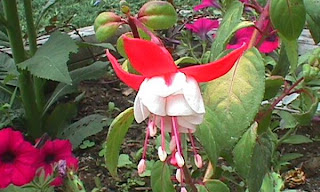Scientific Names
Belamcanda chinensis
Region name
Sunda: Sulinga
Java: Brojo latitude
Minahasa: Kiris
UK / USA: Blackberry lily, Leopard flower, Leopard lily
classification
Division: Spermatophyta
Sub Division: Angiospermae
Class: Monocotyledoneae
Nation: Liliflorae
Tribe: Iridaceae
Marga: Belamcanda
Type: Belamcanda chinensis L, DC
The characteristics
Habitus: Shrubs, 1-1.5 m high Trunk Upright, massive, flat, berbuku-books, smooth, greenish yellow
Leaves: Single, covering the stem, lanceolate, flat edge, pointed tip, base of the split, parallel pertulangan, 50-60 cm long, 2-4 cm wide, bluish green
Interest: Compound, androgynous, at the end of the rod, elongated triangular petals, purple, stamens three, 1 to 1.5 cm long, yellow anthers flattened, yellow, yellow buds, crown form of stars, hexagons, subtle , orange
Fruit: Square, round elongated, beaked, green
Seed: Round flat, white
Roots: The fibers, dirty white
Chemical Ingredients
Flowers, leaves and roots contain saponin brojo latitude, the flowers also contain alkaloids and tannins and the leaves also contain polyphenols.
property
Flowers and leaves brojo latitude efficacious as a febrifuge and nutritious roots for an enema. To febrifuge used 1-5 grams of fresh flowers and leaves Belamcanda chinensis, washed, pounded until creamed, diparamkan on the body.
READ MORE - Belamcanda chinensis
Belamcanda chinensis
Region name
Sunda: Sulinga
Java: Brojo latitude
Minahasa: Kiris
UK / USA: Blackberry lily, Leopard flower, Leopard lily
classification
Division: Spermatophyta
Sub Division: Angiospermae
Class: Monocotyledoneae
Nation: Liliflorae
Tribe: Iridaceae
Marga: Belamcanda
Type: Belamcanda chinensis L, DC
The characteristics
Habitus: Shrubs, 1-1.5 m high Trunk Upright, massive, flat, berbuku-books, smooth, greenish yellow
Leaves: Single, covering the stem, lanceolate, flat edge, pointed tip, base of the split, parallel pertulangan, 50-60 cm long, 2-4 cm wide, bluish green
Interest: Compound, androgynous, at the end of the rod, elongated triangular petals, purple, stamens three, 1 to 1.5 cm long, yellow anthers flattened, yellow, yellow buds, crown form of stars, hexagons, subtle , orange
Fruit: Square, round elongated, beaked, green
Seed: Round flat, white
Roots: The fibers, dirty white
Chemical Ingredients
Flowers, leaves and roots contain saponin brojo latitude, the flowers also contain alkaloids and tannins and the leaves also contain polyphenols.
property
Flowers and leaves brojo latitude efficacious as a febrifuge and nutritious roots for an enema. To febrifuge used 1-5 grams of fresh flowers and leaves Belamcanda chinensis, washed, pounded until creamed, diparamkan on the body.






























